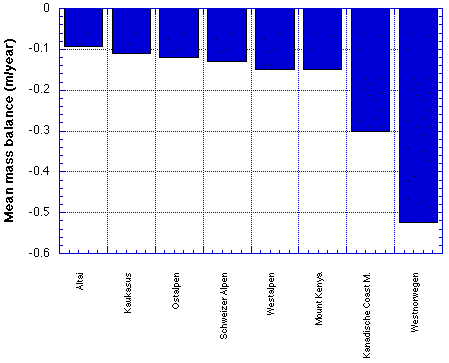
Fig. 1.: Mean mass balance (m/a) in different mountain regions (since ca. 1900) calculated from length change data (Source: Hölzle, M., Dischl, M., & Frauenfelder, R. (2000). Weltweite Gletscherbeobachtung als Indikator der globalen Klimaänderung. Vierteljahresschrift der Naturforschenden Gesellschaft in Zürich 145/1: 5-12.)
| Year | 1980-1995 | 1995/96 | 1996/97 |
| mean (annual) net balance: | - 258 mm | - 378 mm | - 478 mm |
Taking the two last years together, the mean mass balance was negative by 428 mm. The calculated mean is almost two-thirds higher than the average 1980-1995. The rate of glacier melt in the northern hemisphere, thus, clearly accelerated during the two years reported. The mean specific net balance (-306 mm) for the seven years 1991-1997 is markedly higher than the decadal mean of 1980-1990 (-259 mm). The difference corresponds to an increase in additional energy flux of about 0.05 W/m2 per year.
The mean of all 32 glaciers is strongly influenced by the great number of Alpine and Scandinavian glaciers. However, considering the mean balance of the 10 mountain ranges involved the result is similar: -350 mm for the seven-year period of 1991-1997 are clearly higher than the mean of 1980-1990 (-317 mm).
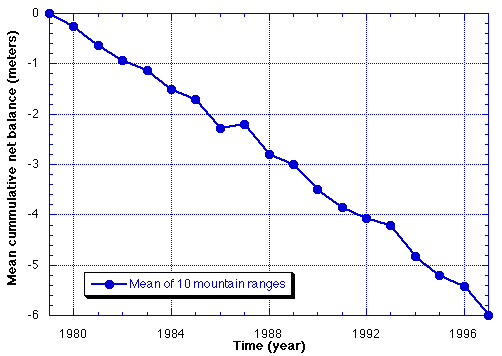
Fig. 2.:Mean cummulative specific net balance for 32 glaciers of 10 mountain ranges in the northern hemisphere. The mean mass change is around 0.3 m/a. (Source: Hölzle, M., Dischl, M., & Frauenfelder, R. (2000). Weltweite Gletscherbeobachtung als Indikator der globalen Klimaänderung. Vierteljahresschrift der Naturforschenden Gesellschaft in Zürich 145/1: 5-12.)
- Regions that lose major parts of their glacier cover will experience alterations in hydrology.
- The glaciers will initially provide extra runoff from melting; but as the ice diminishes, the runoff will wane.
- Because revegetation of terrain is slower at high altitudes, deglaciated areas will be subject to erosion and decreased stability, heightening the need to protect buildings, roads, communication links, and other structures.
- For areas dependent on tourism, uncertain snow cover during peak winter sports seasons, natural hazards such as rock and ice falls, or loss of scenic beauty (e.g. the Bosson glacier in the Mont-Blanc region, which is a characteristic feature in the panoramic view of Chamonix) are of particular concern.
Additional informations on future impacts of glacier shrinkage can be found on: Climate Change Impacts - an interactive informationsystem on the regional impacts of climate change
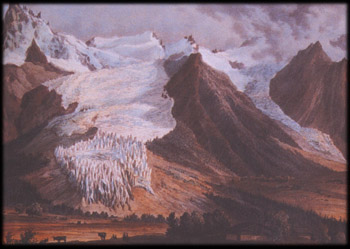
Chamonix - Mont Blanc, Besson Glacier 1818
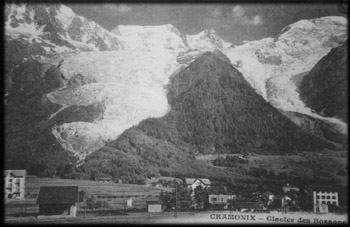
Chamonix - Mont Blanc, Besson Glacier 1928
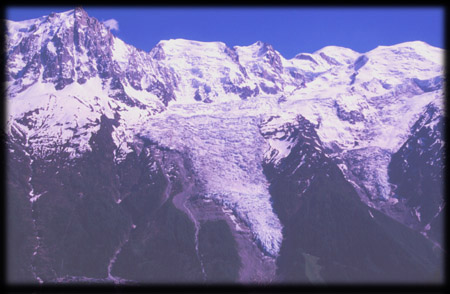
Chamonix - Mont Blanc, Besson Glacier today
Image copyright by: History of Mont-Blanc Bosson glacier
Sources:
World Glacial Monitoring Service
Glacier Mass Balance Bulletin, No. 5, 1999. Haeberli W., M. Hoelzle and R Frauenfelder (ed.),
Department of Geography, University of Zurich - IAHS (ICSI) / UNEP / UNESCO
Haeberli, W. and M.Beniston, 1998: Climate change and its impacts on glaciers and
permafrost in the Alps. Ambio 27/4, 258-265.
GECR, 1998. Melting glacier destabilizes Austrian peak. Global Environmental Change Report,
vol. X, no. 22, p. 6.
Union of Concerned Scientists, Climatehotmap
U.S. National Snow and Ice Data Center (NSIDC)
Cebon, P., U. Dahinden, H.C. Davies, D. Imboden, and C. Jaeger (ed.), 1998: Views from the
Alps - Regional Perspectives on Climate Change. MIT Press, Cambridge, Massachussetts,
515 p.
Intergovernmental Panel on Climate Change, IPCC, Second Assessment Report, 1995, The Global Climate System Review, December 1993-May 1996, WMO 856